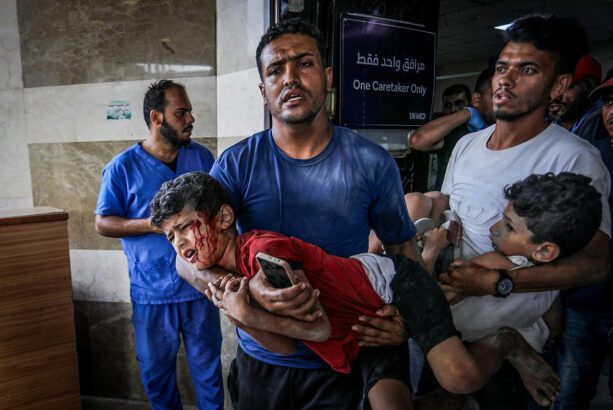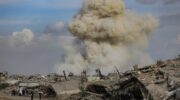American surgeon Feroze Sidhwa has volunteered in war zones around the world. But nothing prepared him for the moment when Israel bombed his hospital in Gaza – or the carnage he saw there.
By Michal Feldon, Reposted from +972 Magazine, April 09, 2025
On the evening of March 23, Feroze Sidwha, a trauma and critical care surgeon who had recently arrived in Gaza from California as a volunteer medic, was on his way to the surgical ward in Nasser Hospital when an Israeli airstrike tore right through it. Israel’s army said the strike was targeted at Ismail Barhoum, a senior figure in Hamas’ political bureau who was being treated for wounds sustained in a previous airstrike only days earlier, but the bombing also killed a 16-year-old boy and wounded several more patients.
The slain teenager, named Ibrahim, was Feroze’s patient. “Ibrahim was supposed to go home today,” Feroze said when we spoke the day after the bombing. “He had some injuries to his distal colon, which we repaired, but they were pretty destructive, so we gave him a protective colostomy. He was recovering on the ward and was in good shape. I never expected to have a patient killed in his hospital bed.
“If I hadn’t been pulled into the intensive care unit, I probably would’ve been killed standing next to Ibrahim,” he continued. In response to the claim that the airstrike targeted a Hamas leader, he added: “It’s one of the most cherished aspects of humanitarian law that when a person is wounded, not participating in combat, and being attended to by a doctor, they are a protected person.”
I first encountered Feroze last October, when he and almost 100 other American medical personnel sent an open letter to the president and vice president of the United States detailing what they had seen during their time volunteering at hospitals in Gaza, and calling for an end to the war and to U.S. weapons shipments to Israel. Three weeks later, I was among a group of over 100 Israeli medical personnel who signed another open letter to President Biden and Vice President Harris in solidarity with those American doctors. Since then, Feroze and I have continued our collaboration.
After returning home from his first volunteering deployment to Gaza’s European Hospital in March-April 2024, Feroze barely paused for breath. Whenever I tried to get hold of him — for a Zoom conversation or to give a lecture at the recent conference of Israeli medical personnel against the war — he was busy in Washington with some political committee or another, which he somehow manages to fit in among countless interviews, webinars, and articles. In March, he returned to Gaza for a second volunteering stint.

This time, as part of a team from MedGlobal, Feroze took up residence in the surgical department at Nasser Medical Complex in the southern city of Khan Younis. With 450-500 patient beds, Nasser is currently the largest functioning hospital in southern Gaza. The Israeli military has attacked the complex on several occasions since October 7; after a month-long siege that culminated in the arrest of 70 staff in February 2024, the hospital was declared non-functional, but has since been able to recover some of its capacities.
Despite the incredibly difficult conditions since Israel shattered the ceasefire last month, Feroze describes his first stint a year ago as being even tougher than his latest one, which ended on April 2. “Last time, we got to the European Hospital just as the battle of Khan Younis was going on; there was never a moment without bombing,” he explained. “Only on April 1 [2024] — the day of the World Central Kitchen killings [when Israeli drones attacked an aid convoy, killing seven workers] — did the drones stop buzzing, and even then it was only for 12 hours. I guess they didn’t want any more bad press [that day].”
Moreover, unlike the European Hospital a year ago, Nasser Hospital is not currently doubling up as a displaced persons camp. “You couldn’t function — women were cutting vegetables and draining soup in the ICU sink; it was completely ridiculous,” Feroze said. “There are a lot more staff here, too, and a lot more who speak English. Whereas last time I never operated with another surgeon, this time there’s a Palestinian surgeon in every surgery. The hospital wasn’t bombed last time, though, so I guess that’s different.”
Feroze is no stranger to conflict and disaster zones, having previously volunteered in Ukraine, Haiti, and Zimbabwe. But the situation in Gaza, he emphasized, is incomparable. “I’ve been to Ukraine three times since the Russian invasion — which, before Gaza, was the worst country in the world for attacks on health facilities,” he said. “At no point did I expect to just be blown up by the Russians. It’s completely crazy.”
A designated area for children to die
On the face of it, it could be hard to understand what drove this surgeon to volunteer in war-ravaged Gaza and then to become such a fierce campaigner against the Israeli bombardment. Feroze has no personal connection to Palestine; his family is originally Persian-Indian, and he even admits to his parents harboring some Islamophobic sentiments following their own history of persecution. He only knows three words in Hebrew, and two in Arabic — the most important being “khalas,” which he usually uses to tell someone their family member has passed away.
And yet he chose to return to Gaza last month for a second visit, seizing the opportunity presented by a ceasefire that he knew full well wouldn’t last.

The bombing of the hospital was not, in fact, the most dramatic event Feroze experienced during his latest visit. A few days prior, on March 18, Israel carried out what has come to be known as the “Ramadan Massacre,” simultaneously attacking around 100 locations from the air during the suhoor meal. More than 400 Palestinians were killed, of whom 174 were children.
“When the bombing started at 2 in the morning, the door to our living quarters was actually blown open, and it slammed into the cabinet behind it — that was what woke me up,” Feroze recalled. “I think we saw a total of 130 patients in that six-hour period. I did six operations immediately and three more over the course of the day. Half of those were on small children, which I am not used to at all. I did more pediatric trauma that night than I do in a year in the United States.”
For comparison, Feroze recalled the aftermath of the Boston Marathon bombings in 2013, when he was working as a resident at the Boston Medical Center. “That day, every major trauma center in the whole city of Boston — with a combined capacity of about 4,000 beds and over 100 capable surgeons — all of them together saw the number of patients that we saw in one night in Nasser Hospital on March 18,” he explained. “Only 10 of the injured were children, whereas here, a third to a half of the patients were children.
“So this was a huge mass-casualty event, but it wasn’t even the worst they’ve seen here,” he continued. “The surgeons [at Nasser Hospital] remember days when the surgical department did 100 operations in one day. That is more resource utilization in this one hospital than any other hospital on earth has ever experienced, not even in New York after 9/11 — and they were doing this day in and day out for months.
“The local medical teams here are very experienced, and they did a phenomenal job [on March 18],” Feroze went on. “There was still a lot of chaos, but they kept the front of the hospital clear and triaged the patients.”
Feroze explained how, as is customary during mass-casualty events around the world, medical staff divided incoming patients into color categories: green for “walking wounded,” meaning no risk of life; yellow for possible risk of life but seemingly stable, so they can wait to be evaluated; red for immediate evaluation — usually due to airway, breathing, or circulation problems; and black for beyond help.

“When someone is marked as black, they are taken directly to the morgue,” he said. “Either they are decapitated, have fixed and dilated pupils with no heartbeat, or they’ve been ripped to shreds or disemboweled. It’s culturally impossible to black-tag children here and tell the ambulance driver to take them directly to the morgue. That’s why there’s a designated area for children to die, alongside other dying children, where their families can stay with them and pray.”
The first thing Feroze did when the victims began arriving in the early hours of March 18 was tell a father to take his child to this area. “She had agonal breathing and a very thready pulse with very bad shrapnel injuries to her brain. There was no neurosurgeon here, and we had to tell her father, ‘Sorry, she isn’t going to survive.’
“I picked her up and put her in his arms, and then I just pointed, because I couldn’t explain in Arabic. I have no idea whether he knew his daughter was going to die, but it seemed like he understood.”
‘This isn’t an Israeli attack on Gaza, it’s a U.S.-Israeli attack’
Feroze is fully aware that his decision to volunteer in Gaza is putting his life at risk. “This is the most violent place I’ve ever been by a huge margin,” he said. “It’s probably the most violent place on earth in the last 60 years.”
This is the first thing he says to any physician who contacts him to discuss following in his footsteps. “They have to understand that they’re going to a place where if the Israelis want to murder you, they will, and they will get away with it — and your own government will do absolutely nothing about it.” (The day before we spoke, a clerk from the U.S. Embassy in Israel had called to check up on Feroze upon seeing his tweet about the hospital bombing. “Can you please tell the Israelis to stop bombing Nasser Hospital?” he told her. “You know, that isn’t really our role,” she replied.)

“Maybe it’s a defense mechanism, but it’s not the suffering that gets to me, it’s the fact that I know I bear a huge amount of moral responsibility,” Feroze continued. “This is not an Israeli attack on Gaza — it’s a U.S.-Israeli attack. When I was jaw-thrusting a little girl and I had three or four minutes until her intubation was set up, I was just thinking: ‘Was it my tax dollars that put the shrapnel in this girl’s brain, or was it my neighbor’s?’”
In some moments, Feroze struggles to find meaning in his volunteering work in Gaza. “Truth be told, I’m not doing a whole lot that’s useful here other than bearing witness,” he said. “I hate saying this, but I think the most useful thing I’ve done here is have one of my patients get killed and then draw attention to the fact that a 16-year-old boy shouldn’t be blown up in a hospital.”
Still, Feroze describes healing Palestinian children’s wounds as “recharging my moral batteries,” and he guesses that his very presence in the hospital serves as a deterrent, albeit limited, against a larger Israeli attack. “It is possible that my being here protects [the children] a little bit; maybe if I weren’t, Israel would have used a 2000-pound bomb. They have the capacity to tear down the whole hospital, but if they kill a bunch of internationals, that would look really bad.
“There are parts of you that you can lose, and parts you can’t,” he went on. “And I’m not religious, but I think you can’t lose your soul, your psyche, your conscience. At the end of the day, you have to be able to look at yourself in the mirror. If you can’t, life just isn’t worth living.”





